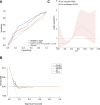Role of Charlson comorbidity index in predicting intensive care unit readmission in patients with aortic aneurysm
- PMID: 39496060
- PMCID: PMC11537597
- DOI: 10.1097/MD.0000000000040033
Role of Charlson comorbidity index in predicting intensive care unit readmission in patients with aortic aneurysm
Abstract
The purpose of this study was to investigate the value of the Charlson comorbidity index (CCI) in predicting intensive care unit (ICU) readmission in aortic aneurysm (AA) patients. Patient information came from the Medical Information Mart for Intensive Care- IV (MIMIC-IV) database. The relationship between CCI and ICU readmission was analyzed by restricted cubic spline, generalized linear regression, trend analysis, and hierarchical analysis. The clinical value of CCI in predicting ICU readmission was analyzed by receiver operating characteristic curve, decision curve analysis, XGBoost regression, and random forest regression. A total of 523 patients with AA were enrolled in the study. Patients with AA who were readmitted to the ICU had higher width of red blood cell distribution width (RDW) and higher CCI. CCI had better performance and clinical net benefit for predicting ICU readmission than RDW. An independent nonlinear relationship was found between CCI and ICU readmission. The trend analysis suggested that the risk of ICU readmission increased with higher CCI scores. The hierarchical analysis showed that their association was mainly found in surgery requirement populations regardless of AA types. Further, CCI was found to have better clinical value in predicting ICU readmission of thoracic aortic aneurysm (TAA) patients undergoing surgery. Age, renal disease, chronic lung disease, and dementia were important components of CCI in predicting ICU readmission of TAA patients undergoing surgery. CCI was independently associated with the ICU readmission of AA patients in a positive relationship and had more favorable prediction performance in TAA patients who underwent surgery.
Copyright © 2024 the Author(s). Published by Wolters Kluwer Health, Inc.
Conflict of interest statement
The authors have no funding and conflicts of interest to disclose.
Figures



References
-
- Fernando SM, McIsaac DI, Kubelik D, et al. . Hospital resource use and costs among abdominal aortic aneurysm repair patients admitted to the intensive care unit. J Vasc Surg. 2020;71:1190–9.e5. - PubMed
-
- Rapoport J, Teres D, Zhao Y, Lemeshow S. Length of stay data as a guide to hospital economic performance for ICU patients. Med Care. 2003;41:386–97. - PubMed
-
- Griffiths JD, Price-Lloyd N, Smithies M, Williams JE. Modelling the requirement for supplementary nurses in an intensive care unit. J Oper Res Soc. 2005;56:126–33.
-
- Chan KS, Tan CK, Fang CS, et al. . Readmission to the intensive care unit: an indicator that reflects the potential risks of morbidity and mortality of surgical patients in the intensive care unit. Surg Today. 2009;39:295–9. - PubMed
-
- Chen LM, Martin CM, Keenan SP, Sibbald WJ. Patients readmitted to the intensive care unit during the same hospitalization: clinical features and outcomes. Crit Care Med. 1998;26:1834–41. - PubMed
Publication types
MeSH terms
LinkOut - more resources
Full Text Sources

